Next- DePauw November 22, 1919
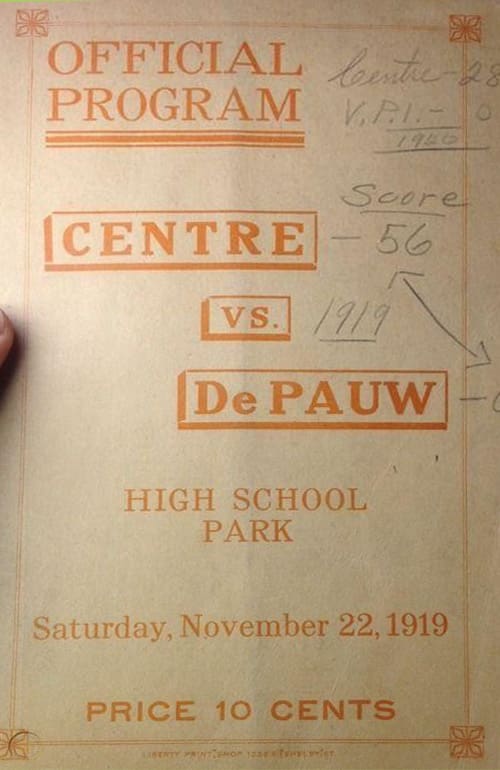
High School Park was the new stadium built behind Louisville Boys School in 1915 which became Louisville Male in 1918. Someone had penciled in the 1920 Centre-VPI score in the right upper corner along with the 1919 Centre-DePauw score.
Louisville was desperate for football. For years, the big game had been the annual high school match between Louisville Male and Manual. However, the consolidation of the two schools into Boys High, the merged school that Bo, the Reds, and other “Briar Jumpers” from Somerset had so thoroughly demolished, 51-6, in 1916, had put an end to that rivalry until Boys High split back into Male and Manuel Highs in 1918.
The University of Louisville began fielding a team in 1912 but shut down during World War I and didn’t get back on the gridiron again until 1921.
The citizens of Louisville, led by alumni of Centre, had tried to get Centre to move the November 15 game with the University of Kentucky to their city. They reasoned that since Louisville was the largest metropolitan community and home of the greatest number of Centre graduates, it would only be natural to have the Colonels play there. They also stated that since Centre had begun to attract national recognition, it would follow that more sportswriters would come to a game there than to Danville, thereby gaining even more publicity.
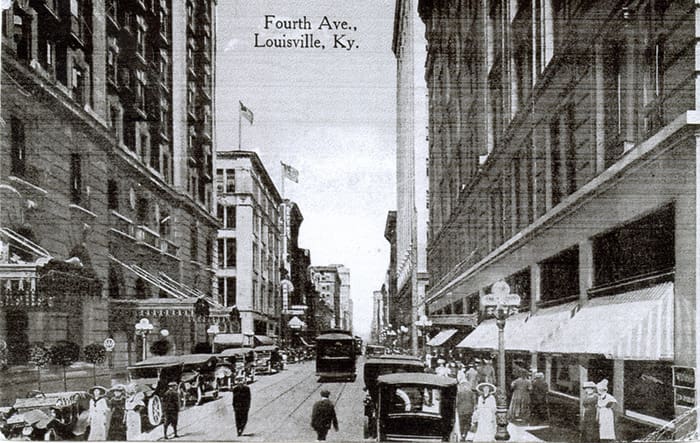
Louisville's citizens felt Centre would receive more recognition if the Colonels played there. The Seelbach Hotel is near left in this photo of downtown.
Dr. Ganfield was sympathetic but pointed out the very obvious fact that since the Kentucky game was Centre’s Homecoming, moving the game simply wasn’t possible.
“How do you have a Homecoming if you’re not playing at home?”
A compromise was reached. Centre contacted DePauw and asked if their November 22 game could be switched from Greencastle, Indiana to Louisville, and DePauw agreed. Thus began a literal love affair between Louisville and Centre for the next 5 years.
The Seelbach Hotel at Fourth and Walnut was the premiere lodging spot in the Derby City, having been constructed in 1905 by the Seelbach brothers, Otto and Louis, immigrants from Bavaria. The hotel was virtually taken over by the team and its supporters for the weekend.

Louisville headquarters for the Centre team and followers for the next 5 years. ( See more about the Seelbach family in Chapter 126. )
The game was the hottest ticket in town. All 6,000 seats in the stadium, south of the downtown at Brooke and Breckinridge behind what was now Male High, quickly sold out. Extra boxes were constructed and the official in charge stated that there had been 10,000 requests and that several thousand were going to be disappointed.
DePauw was coming off a 24-0 loss to Purdue in West Lafayette. Coach Edbert Buss, who had been at the helm since 1916 and was the Tigers' coach during Centre's last loss on October 20, 1917, didn't accompany his team to Louisville due to illness. Certainly, he was missed by his players. Centre, on the other hand, was in good shape. Only one Colonel was hurt, the little speedster Chick Murphy, who had a non-displaced rib fracture. He was told he could suit up but not play unless being needed.
Before the game, there had been discussion about Red Weaver and his accuracy in kicking extra points. His streak stood at 30, and people were beginning to take notice.
Saturday, November 22, was another of those perfect autumn days for a football game. There had been a slight sprinkle the night before, but the field was in excellent shape by game time, certainly an advantage for the Colonels with all of their speed.
Centre put on an awesome display in Louisville. After an initial exchange of punts, the offensive machine got into gear. The Colonels took over on their own 20, and 8 plays later, were on DePauw’s 19. On the next play, Bo fired a perfect pass to Army who stepped over the goal.
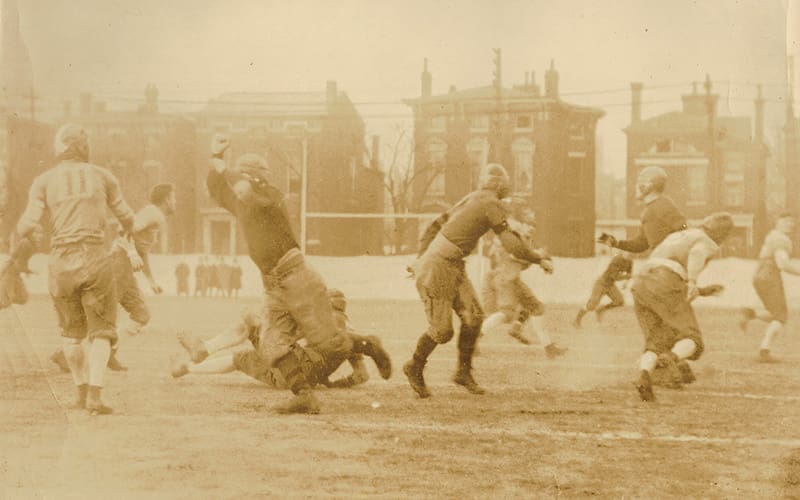
Bo McMillin (11) shown after firing a pass during the DePauw game
Weaver kicked the first of 8 PAT’s for the afternoon, running his streak to 38 by the time the game was over.
It was 7-0 after the first quarter, 21-0 at the half, 35-0 at the end of the third period and 56-0, the same score as the Kentucky game, when the final whistle blew.
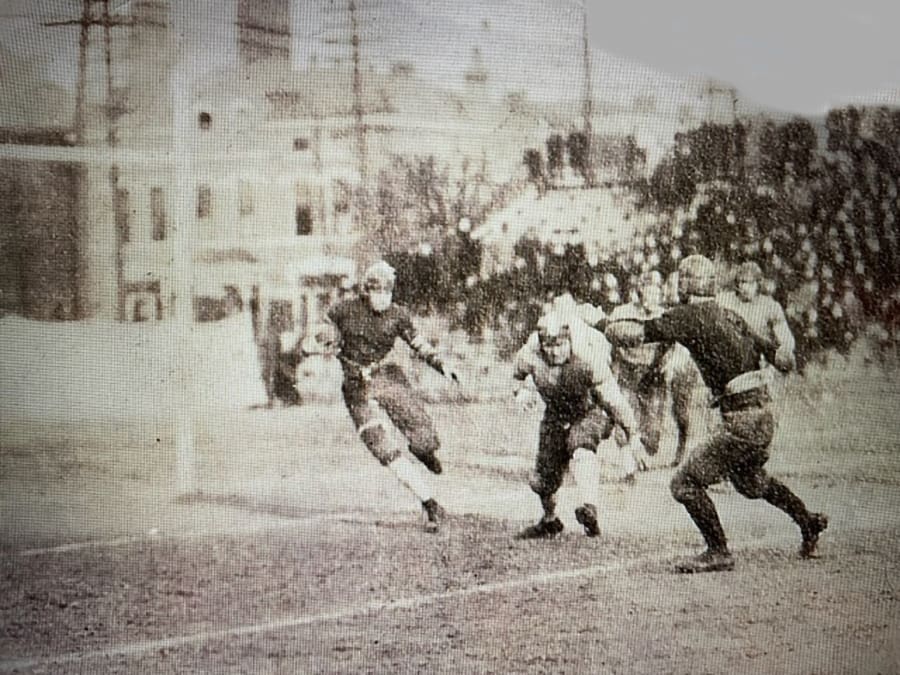
Centre back returning one of the many DePauw punts
The statistics revealed how dominant Centre had been.
DePauw only threatened once when the Tigers’ quarterback, “Galloping” Galloway, returned a second quarter kickoff to Centre’s 10, but when he tried to shift the ball to his opposite arm, fumbled it away. It was indicative of the afternoon for the boys from Greencastle as they gained a total of 87 yards in 33 plays.
Meanwhile, Centre compiled the following;
Bo got 286 yards on 37 carries
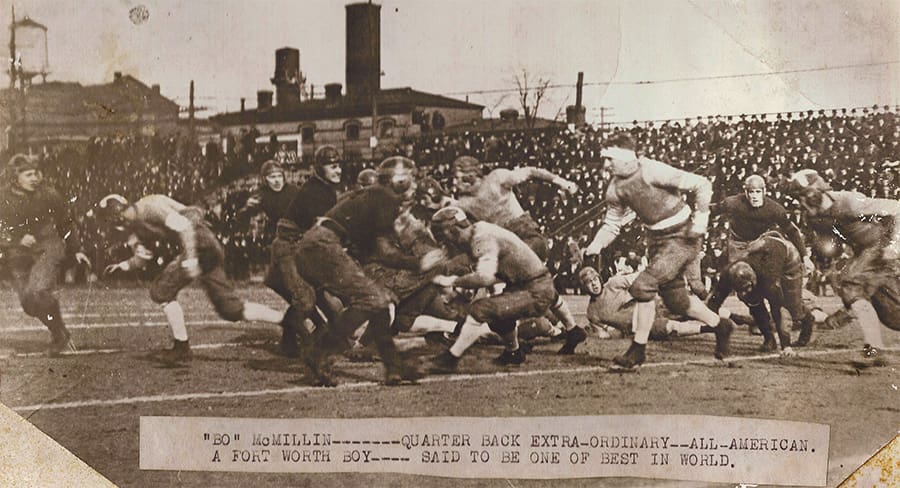
A familiar scene over the years. Bo McMillin, carrying the ball, is led by Red Roberts with the white headband who is about to take out a DePauw defender. Red Weaver is lying on the ground looking back toward the evolving play after having completed a block. This great photograph was taken during the Colonel's 56-0 win over DePauw in Louisville. The sell-out game was played in the stadium behind Male High on Brooke and Breckinridge, the same location where Bo and the two Reds put a 51-6 shellacking on what was then called Boys High while playing together for the Somerset "Briar Jumpers" in 1916.
Terry Snowday gained 167 on 14 carries.
Red Roberts, 113 on 21, mainly on straight line plunges.
Army Armstrong picked up 77 on 10.
Lefty Whitnell, 78 on 7.
Allen Davis, 80 on 6.
Uncle Charlie even put seldom used Max MacCollum, a Louisville native, in the backfield so that the locals could see one of their own in action.
Max responded by trucking it for 26 yards in 3 carries.
Overall, Centre gained an incredible 827 yards in 98 plays, for an average of nearly eight and half yards every time a Colonel touched the ball.
In reading contemporary accounts on the game in the Louisville newspapers, it would seem that Centre primarily depended on its ground game while playing DePauw, but it was recorded that Bo completed at least 5 passes for another 100 or more yards.
The Louisville Evening Post carried a headline after the game which read, in 1½ inch boldface:
CENTRE TOYS WITH DePAUW
DePauw finished the year at 2-5-1, not an impressive record by any means. But, 3 of those losses were to "Big 10" teams by much less margins than what Centre accomplished, adding even more evidence to the fact that the Colonels had reached the same or greater level of play as the larger, better known colleges to which it wanted to be compared.
Purdue 24 DePauw 0
Northwestern 20 DePauw 0
Michigan 27 DePauw 0
After the game, a dinner was held at the exclusive Pendennis Club, located at the time a block down Walnut from the Seelbach in what was the old Belknap Mansion.
President Ganfield was in attendance, and his guest was the newly elected governor of Kentucky, Edwin P. Morrow, a native of Somerset, Kentucky, hometown of Red Roberts.
Governor Morrow stated, “I count it as a great honor to have been elected as the governor of the great Commonwealth of Kentucky. However, after what I have seen today, I would gladly trade my position with Red Roberts.”
The Louisville alumni association presented leather suitcases to Uncle Charlie, Chief Myers and Bo. Then, a representative of a large group from Owensboro who had taken an early Illinois Central train to Louisville presented a gold watch to their native son, Terry Snowday.
Uncle Charlie ended the comments by stating for the first time publicly, “Before each game, we say a little prayer. I believe that with Divine Assistance, we have what many consider the best football team in the nation,” furthering the growing "Praying Colonels" legend begun in 1917 before the Kentucky game.
The evening ended with the team standing and giving lusty cheers for their hosts, which were returned by the grads who proved that they had not lost their ability to give the old college yells.
The Colonels’ weekend in Louisville had been a true love feast, and their showing both on and off the field assured that they’d be back in the city annually in the coming years.
They were 8-0, the streak was 18, and they had moved one step closer to reaching the long-held goal held by Robert L. “Chief” Myers of being recognized nationally and gaining a slot on the schedules of one of the “Big 3” powers who were the royalty of college football.
